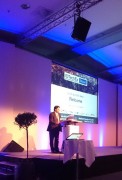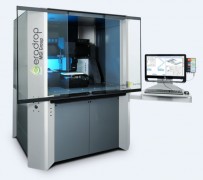IDTechEx’s multi-track conference and exhibition explores the interconnected landscape of printed electronics, wearable technology, energy harvesting, the internet of things (IoT), graphene and 2D materials, 3D printing, and electric vehicles. Collaboration is key to succeeding in materials translation, and for me this was one of the big messages of the 2015 show, which brings together formulation specialists, systems developers, fabrication experts, measurement providers, and customer groups, all under the same roof for two days (or more if you sign-up to masterclasses).

Keynote welcome: Raghu Das, CEO of IDTechEx, briefs the audience on market projections for the printed electronics sector.
Dialogue between technology providers and end-users helps to resolve uncertainty in emerging fields such as printed and flexible electronics where – i) customers can be unsure about what’s possible and ii) suppliers need guidance on market requirements.
Bringing new technology to market
On day one, speakers from Qualcomm and Flextronics outlined how their firms bring new technology to the market. In Qualcomm’s case, its approach is built on four pillars – i) system R&D leadership, ii) design for manufacturability, iii) supply chain management and iv) customer support and engineering. It’s important not to overlook the final step. “The value proposition is only realized if you can propagate this to the customer,” Stein Lundby (R&D manager at Qualcomm) reiterated to audience.
Qualcomm, which Lundby describes as a ‘surface electronics’ company, is exploring opportunities for a hybrid product combining traditional crystalline based electronics with printed electronic components. Developed with Enfucell – a provider of printed power sources – the device features a 3-axis gyroscope and 3-axis accelerometer together with integrated battery and system electronics packaged in a band-aid style form factor. Users can stick the sensor on items such as golf clubs to determine how new products might improve their game, but this is just one possible scenario.
To navigate markets such as wearables, Flextronics – which focuses on production equipment and know-how – has opened design centres to help customers with product development and new use-cases such as electronic displays for athletic clothing. In his presentation, Keith Churches (head of innovation services at Flextronics) showed how the company brings new ideas to the market by configuring product-specific development networks that link the firm’s expertise with partners such as OEMs, universities and research institutes.
Nanomaterials
Directa Plus – which was founded in 2005 and opened its graphene factory in 2014 – used the graphene and 2D materials conference track to talk through its collaboration with Vittoria Industries and highlight early market opportunities for graphene. Dubbed the wonder material, graphene – an ultra-thin layer of carbon – has been shown to have record-breaking electrical, thermal and mechanical properties, but breakthrough results in the lab don’t guarantee commercial success. “You have to be brave to be in the graphene market,” Giulio Cesareo (CEO of Directa Plus) commented.
Vittoria uses Directa Plus’ graphene nanoplatelets to formulate bicycle tyres and wheels with enhanced properties such as heat dissipation and lateral stiffness. There are 165 wheel makers in the world, Rudi Campagne (founder of Vittoria Industries) told the audience, and the use of nanomaterials such as graphene is an effective way for Vittoria to differentiate itself from the competition.
Early uses of graphene provide a platform for growth in other sectors by establishing a materials supply chain. Beyond tyres and wheels, Directa Plus is looking at opportunities for graphene in cleaning up contaminated soil and water. In his talk, Cesareo explained that linked graphene platelets have the potential to remove hydrocarbon pollution from lakes, according to test results. Literature from the firm claims that 1 gram of its Graphene Plus sorbent can adsorb up to 80-90 grams of oil – for more details, visit the GEnIuS project website, a programme co-founded by European Union within the Eco-Innovation initiative.
The discussion then moved on to opportunities for 2D materials in the electronics industry. If graphene does make an impact in this sector it is likely to be driven by novel applications, based on the views of the speakers in the opening session. “Graphene will not replace silicon in standard devices,” commented Guenther Ruhl (lead principal in new materials at Infineon Technologies) during his talk.
Touch screens are also looking unlikely as a big opportunity for graphene. “Graphene transparent conductive films are among the worst performers in a crowded market,” explained Khasha Ghaffarzadeh (head of consulting at IDTechEx). Like Ruhl, he feels that 2D materials could have more impact in new product categories. “The beauty of graphene is that there are many target industries and applications,” Ghaffarzadeh added.
OPV and R2R technology
Analyst events such as the IDTechEx show give attendees a view on tomorrow’s technology today. Two further highlights for me from the keynote presentations were Heliatek’s building integrated photovoltaics (BIPV) and Asahi Kasei’s e-beam fabricated seamless roller for printing transistors.
In the afternoon on day one, Martin Pfeiffer (chief technology officer at Heliatek) outlined what he feels is a sweet spot for OPV – active facades. To compete with silicon, OPV has to bring something different, which it can when applications demand flexible and lightweight solutions. He added that the energy payback for an OPV cell can be as little as 3 months, as determined by the EU project dubbed X10D. Pfeiffer revealed that large-scale trials of the firm’s material were now underway in China and Germany on concrete (in Shanghai), PVC membrane (in Berlin) and glass (in Dresden) structures, with another pilot project due to start soon in Singapore on a glass and steel construction.
There were more glimpses of the future on day two when Masayuki Abe of Japanese giant Asahi Kasei – which operates in chemicals, electronics and healthcare sectors – presented his team’s work on seamless roller mold (SRM) technology for roll-to-roll (R2R) printing of sub-micron feature sizes. To make the mold, they rotated a super-smooth (2 nm roughness) roller under an e-beam writer. Moving the roller laterally (as well as rotating it) allows the team to create complex mold patterns. To test the process, Abe’s group used one of its roller molds to print a 200 ppi, 125 micron pitch TFT array. Abe was clearly proud of his team’s results and sees a bright future for the technique. “SRM will bring about the realization of high-resolution printing,” he told the audience.
Dates for your diary
The IDTechEx conference and exhibition takes place twice annually – once in Europe and once in the US (18-19 Nov 2015). The event returns to Berlin on the 27th and 28th of April 2016.
Related stories on TMR+
MC10 declares that the future of electronics is flexible
Roll-to-roll production could ramp up market opportunities for graphene
Show report: Metal additive manufacturing 2014 (Sheffield, UK)
Fullerex talks graphene pricing; identifies growth areas and supply targets
Related articles from the journal Translational Materials Research
Industrial-scale inkjet printed electronics manufacturing—production up-scaling from concept tools to a roll-to-roll pilot line – Robert Abbel et al 2014 Transl. Mater. Res. 1 015002
Singlet harvesting copper-based emitters: a modular approach towards next-generation OLED technology – Daniel M Zink et al 2014 Transl. Mater. Res. 1 015003
Analysis of the electrical and optical properties of PEDOT:PSS/PVA blends for low-cost and high-performance organic electronic and optoelectronic devices – Olivia Carr et al 2015 Transl. Mater. Res. 2 015002
Related stories on the web
New Graphene Factory opens in Italy (nanotechweb.org)




Pingback: $5 million investment in Angstron Materials accelerates graphene commercialization | TMR+